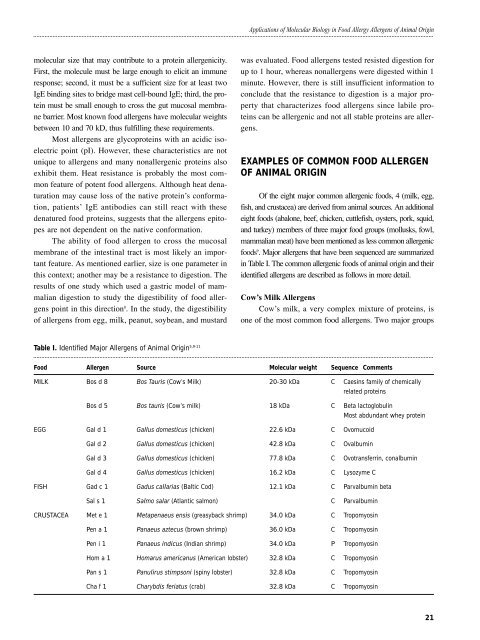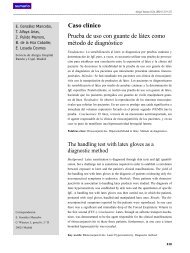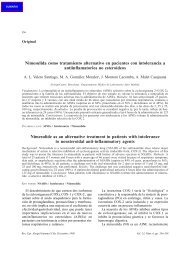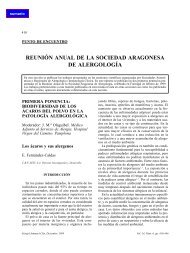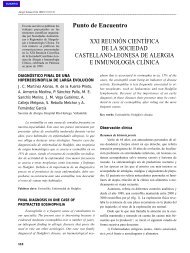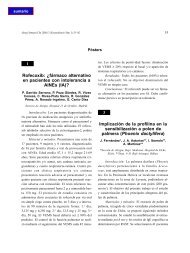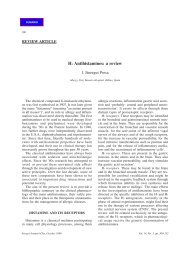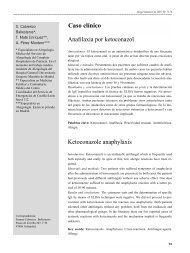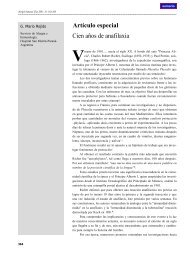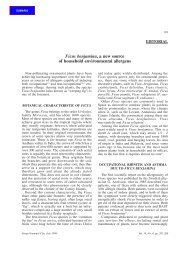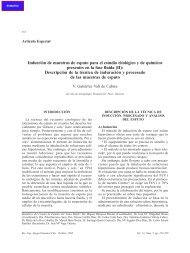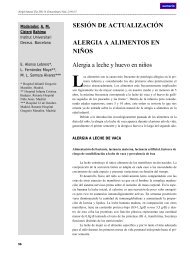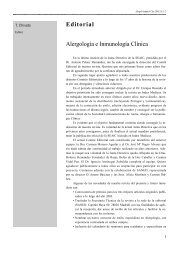Aplicación de la biología molecular en alergia a alimentos
Aplicación de la biología molecular en alergia a alimentos
Aplicación de la biología molecular en alergia a alimentos
Create successful ePaper yourself
Turn your PDF publications into a flip-book with our unique Google optimized e-Paper software.
molecu<strong>la</strong>r size that may contribute to a protein allerg<strong>en</strong>icity.<br />
First, the molecule must be <strong>la</strong>rge <strong>en</strong>ough to elicit an immune<br />
response; second, it must be a suffici<strong>en</strong>t size for at least two<br />
IgE binding sites to bridge mast cell-bound IgE; third, the protein<br />
must be small <strong>en</strong>ough to cross the gut mucosal membrane<br />
barrier. Most known food allerg<strong>en</strong>s have molecu<strong>la</strong>r weights<br />
betwe<strong>en</strong> 10 and 70 kD, thus fulfilling these requirem<strong>en</strong>ts.<br />
Most allerg<strong>en</strong>s are glycoproteins with an acidic isoelectric<br />
point (pI). However, these characteristics are not<br />
unique to allerg<strong>en</strong>s and many nonallerg<strong>en</strong>ic proteins also<br />
exhibit them. Heat resistance is probably the most common<br />
feature of pot<strong>en</strong>t food allerg<strong>en</strong>s. Although heat <strong>de</strong>naturation<br />
may cause loss of the native protein’s conformation,<br />
pati<strong>en</strong>ts’ IgE antibodies can still react with these<br />
<strong>de</strong>natured food proteins, suggests that the allerg<strong>en</strong>s epitopes<br />
are not <strong>de</strong>p<strong>en</strong><strong>de</strong>nt on the native conformation.<br />
The ability of food allerg<strong>en</strong> to cross the mucosal<br />
membrane of the intestinal tract is most likely an important<br />
feature. As m<strong>en</strong>tioned earlier, size is one parameter in<br />
this context; another may be a resistance to digestion. The<br />
results of one study which used a gastric mo<strong>de</strong>l of mammalian<br />
digestion to study the digestibility of food allerg<strong>en</strong>s<br />
point in this direction 8 . In the study, the digestibility<br />
of allerg<strong>en</strong>s from egg, milk, peanut, soybean, and mustard<br />
Table I. I<strong>de</strong>ntified Major Allerg<strong>en</strong>s of Animal Origin 5,9-11<br />
Applications of Molecu<strong>la</strong>r Biology in Food Allergy Allerg<strong>en</strong>s of Animal Origin<br />
was evaluated. Food allerg<strong>en</strong>s tested resisted digestion for<br />
up to 1 hour, whereas nonallerg<strong>en</strong>s were digested within 1<br />
minute. However, there is still insuffici<strong>en</strong>t information to<br />
conclu<strong>de</strong> that the resistance to digestion is a major property<br />
that characterizes food allerg<strong>en</strong>s since <strong>la</strong>bile proteins<br />
can be allerg<strong>en</strong>ic and not all stable proteins are allerg<strong>en</strong>s.<br />
EXAMPLES OF COMMON FOOD ALLERGEN<br />
OF ANIMAL ORIGIN<br />
Of the eight major common allerg<strong>en</strong>ic foods, 4 (milk, egg,<br />
fish, and crustacea) are <strong>de</strong>rived from animal sources. An additional<br />
eight foods (abalone, beef, chick<strong>en</strong>, cuttlefish, oysters, pork, squid,<br />
and turkey) members of three major food groups (mollusks, fowl,<br />
mammalian meat) have be<strong>en</strong> m<strong>en</strong>tioned as less common allerg<strong>en</strong>ic<br />
foods 9 . Major allerg<strong>en</strong>s that have be<strong>en</strong> sequ<strong>en</strong>ced are summarized<br />
in Table I. The common allerg<strong>en</strong>ic foods of animal origin and their<br />
i<strong>de</strong>ntified allerg<strong>en</strong>s are <strong>de</strong>scribed as follows in more <strong>de</strong>tail.<br />
Cow’s Milk Allerg<strong>en</strong>s<br />
Cow’s milk, a very complex mixture of proteins, is<br />
one of the most common food allerg<strong>en</strong>s. Two major groups<br />
Food Allerg<strong>en</strong> Source Molecu<strong>la</strong>r weight Sequ<strong>en</strong>ce Comm<strong>en</strong>ts<br />
MILK Bos d 8 Bos Tauris (Cow’s Milk) 20-30 kDa C Caesins family of chemically<br />
re<strong>la</strong>ted proteins<br />
Bos d 5 Bos tauris (Cow’s milk) 18 kDa C Beta <strong>la</strong>ctoglobulin<br />
Most abdundant whey protein<br />
EGG Gal d 1 Gallus domesticus (chick<strong>en</strong>) 22.6 kDa C Ovomucoid<br />
Gal d 2 Gallus domesticus (chick<strong>en</strong>) 42.8 kDa C Ovalbumin<br />
Gal d 3 Gallus domesticus (chick<strong>en</strong>) 77.8 kDa C Ovotransferrin, conalbumin<br />
Gal d 4 Gallus domesticus (chick<strong>en</strong>) 16.2 kDa C Lysozyme C<br />
FISH Gad c 1 Gadus cal<strong>la</strong>rias (Baltic Cod) 12.1 kDa C Parvalbumin beta<br />
Sal s 1 Salmo sa<strong>la</strong>r (At<strong>la</strong>ntic salmon) C Parvalbumin<br />
CRUSTACEA Met e 1 Metap<strong>en</strong>aeus <strong>en</strong>sis (greasyback shrimp) 34.0 kDa C Tropomyosin<br />
P<strong>en</strong> a 1 Panaeus aztecus (brown shrimp) 36.0 kDa C Tropomyosin<br />
P<strong>en</strong> i 1 Panaeus indicus (Indian shrimp) 34.0 kDa P Tropomyosin<br />
Hom a 1 Homarus americanus (American lobster) 32.8 kDa C Tropomyosin<br />
Pan s 1 Panulirus stimpsoni (spiny lobster) 32.8 kDa C Tropomyosin<br />
Cha f 1 Charybdis feriatus (crab) 32.8 kDa C Tropomyosin<br />
21


